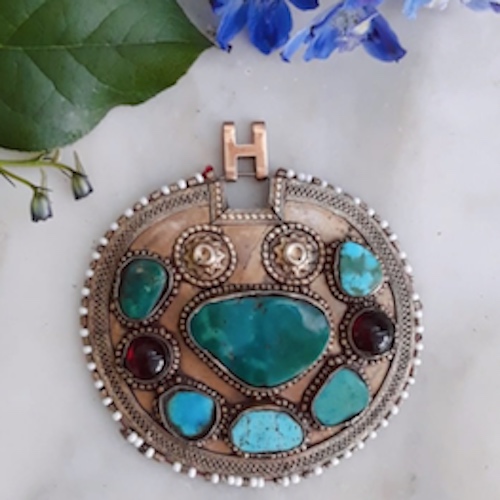Hair is of great importance, even if it is covered. All over the Arab world, hair is cared for, nurtured, braided and decorated with jewellery. This attention to hairstyling is not to be misunderstood as simple vanity but as a profound expression of identity. Jewellery plays a significant part in hairstyling too.
 Tunisian woman photographed around 1900
Tunisian woman photographed around 1900Hairstyles
Hairstyles are of main importance during the various transitions in a woman’s life. A married woman wears a different hairstyle than an unmarried girl, and a girl of marriageable age sports a coiffure different from that of a young child. The amount of time invested in hairstyling is to be taken very seriously; during her travels in Yemen in 1937 and 1938, Freya Stark observed that the wife of a friend spent half a day every two weeks ‘arranging and oiling her curls’. Both hair and head are decorated with jewellery.
 A braid ornament from Palestine
A braid ornament from PalestineHair jewels
All these elaborate hairstyles were both kept in place and enhanced with a variety of hair and head ornaments. In the south of Morocco, silver open-worked containers were worn either braided into the hair or suspended from the head by a woven band. The containers were filled with wool or fabric that had been soaked in scented oil. With every movement of the head, the container swayed with it and dispersed its fragrance. When the scent lost its strength over time, the wool or fabric was easily replaced. Silver hair rings, sometimes embellished with trade beads, were braided in and added to the resplendent sight.
In the United Arab Emirates and Oman, the single plait of an unmarried girl was kept together with a silver clip. Another way of adorning plaits was by attaching small ornaments to their ends. These small silver ornaments were worn in various numbers in Oman: girls would wear six, married women eight or ten. These could also hold fragrant substances. Palestinian women decorated their long braids with silver elements called
qarmal.
 A forehead ornament from Saudi Arabia
A forehead ornament from Saudi ArabiaHead jewels
Hair jewels are worn in combination with head jewels as well. In the Najd in Saudi Arabia for example, women would wear a spectacular forehead ornament called
kaffa. This was made of thin sheet cold, encrusted with
turquoise
Turquoise: (French: turquois – present day Türkiye; Synonyms: firuze
Firuze: (Persian: pērōzah – "victory", later Arabic: fayrūz; Synonyms: firuze, pheroza), is a naturally occurring opaque mineral mined in abundance in Khorasan province of Iran and has been used for making dye for centuries. , pheroza), is a naturally occurring opaque mineral mined in abundance in Khorasan province of Iran and has been used for making dye for centuries. The term is a derivative of the French word for the country Türkiye once called Turkey. and garnet, and suspended over the head. Two matching pieces were worn on either side of the head, and chunky
turquoise
Turquoise: (French: turquois – present day Türkiye; Synonyms: firuze
Firuze: (Persian: pērōzah – "victory", later Arabic: fayrūz; Synonyms: firuze, pheroza), is a naturally occurring opaque mineral mined in abundance in Khorasan province of Iran and has been used for making dye for centuries. , pheroza), is a naturally occurring opaque mineral mined in abundance in Khorasan province of Iran and has been used for making dye for centuries. The term is a derivative of the French word for the country Türkiye once called Turkey. set in brass or silver was braided into the hair. A spectacular sight!
Another impressive headdress that combined both head-covering and jewellery is the
shabka, worn in Oman. This headdress, made of plaited goat leather and decorated with silver studs, resembles a wig and was worn in Wahiba Sands. A similar use of leather is found in a forehead ornament from southern Morocco and Mauritania called
sharwita: the leather strands are heavily decorated with colourful beads, shells and amulets.
These are only a few examples of the incredibly rich and varied ways of head adornment: we at The
Zay
Zay: (Arabic: costume, Pl. azyaā’), a set of clothes in a style typical of a particular country or historical period. would love to hear your personal stories about them!
Where can I read more?
There are many books about jewellery. A few suggestions to enjoy about hair and head jewellery are:
- A World of Head Ornaments: Africa, Asia, Oceania, America by Anne van Cutsem
- The power of headdress by Biebuyck & Van den Abeele
*Feature image: Braid decorations from Oman





 Tunisian woman photographed around 1900
Tunisian woman photographed around 1900 A braid ornament from Palestine
A braid ornament from Palestine A forehead ornament from Saudi Arabia
A forehead ornament from Saudi Arabia